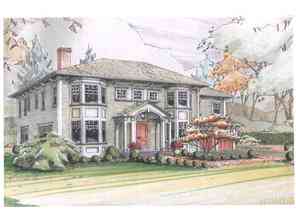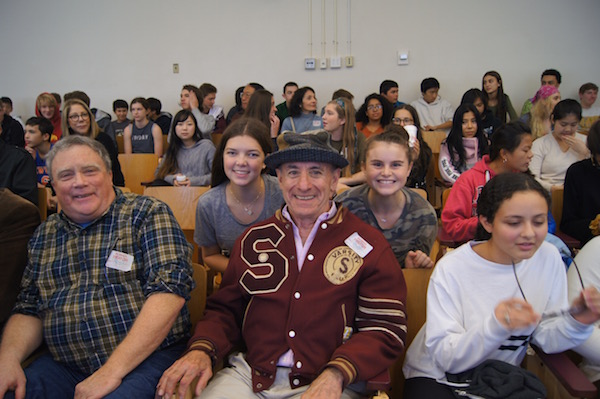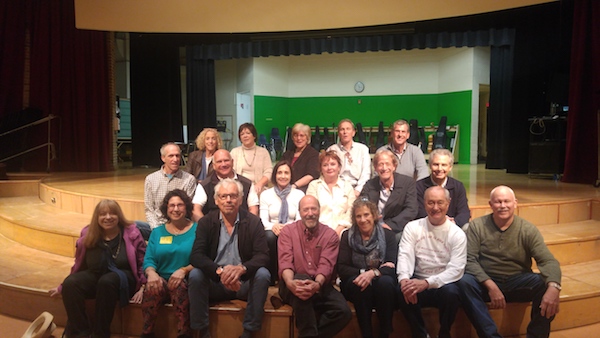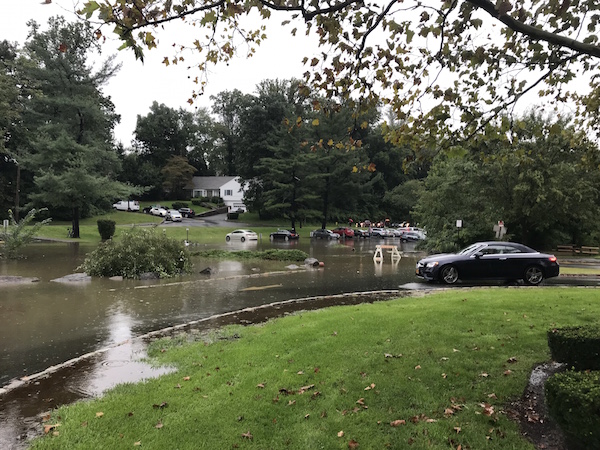Land Use Committee Discusses BAR Reviews and Zoning Requirements
- Details
- Written by Laura Halligan
- Category: The Goods
 On Tuesday October 23 the Scarsdale Land Use Committee met to review “priority” issues, including how best to assist the Scarsdale Board of Architectural Review (BAR) in preserving the character of Scarsdale and how to address the “bulky house issue.”
On Tuesday October 23 the Scarsdale Land Use Committee met to review “priority” issues, including how best to assist the Scarsdale Board of Architectural Review (BAR) in preserving the character of Scarsdale and how to address the “bulky house issue.”
First, Scarsdale Building Inspector Frank Diodati discussed ways in which the building department may be able to help the BAR in handling the 15 to 20 applications it considers during each of its meetings. Diodati reviewed numerous BAR applications to determine challenging issues brought before the board, and matters that may be settled through building codes/requirements, rather than aesthetics or neighbors’ concerns.
Diodati suggested that some specific structures can be considered less aesthetic in nature, and could be handled by his department, including 1) fences placed in front yards; 2) porch enclosures; 3) rear decks and deck enlargements; 4) sheds; 5) dormers; and 6) pergolas, gazebos and trellises.
Jessica Kourakos, BAR chair, cautioned Diodati that these structures often aren’t easily viewed in terms of building codes. Many residents have opinions about where they’re placed, how they’ll be used, and the noise they may generate, among other issues. Rather, she suggested that simpler projects that meet basic guidelines should go to the building department and more complex construction should require BAR review. The building department, with input from the BAR, would establish those guidelines.
A prime example is solar panels. “Solar panels are a hot topic, “ Diodati said, acknowledging the need to balance Scarsdale’s interest in promoting renewable energy and considering solar panels’ general appearance. He stated that solar energy systems and residents’ use of green technology must be encouraged, and the BAR should develop a checklist of aesthetic requirements (coatings, hardware, etc.) for residents to review when considering the panels. Once the checklist was satisfied, the building department could then ensure proper installation. However, Kourakos pointed out that solar panels still should require residents’ input, as they affect sightlines and views from neighboring properties.
BAR Member Daniel Finger added, “Solar panels should be added to the building department’s responsibility; it is clear that residents want them, but there’s nothing aesthetically pleasing about them. You need to get past appearance and (focus on) a policy of green awareness.”
Kourakos then said, “If things are taken away from the BAR, such as solar panels, you should allow neighbors to comment.” She suggested that “The village should develop clear guidelines with an emphasis on aesthetics” to provide clarification and make the process less contentious. She explained that the BAR has referred to existing guidelines for solar panels (e.g., use of black grids vs. more obvious white grids) and often received technical responses affecting aesthetics that aren’t addressed by existing standards (e.g., which color panels are more efficient).
Since the technology continues to evolve and more attractive options may be available, Ron Schulhof, Scarsdale Conservation Advisory Council chair, offered to review Scarsdale’s guidelines, which are two years old. “The CAC can help update them based on the technology available today.” Diodati also reminded BAR members that they should consult the village when faced with any such technical issues they feels they can’t address, such as lot coverage, storm water and FAR.
Diodati continued by mentioning another possible means to ease the BAR’s workload – limiting BAR review to new homes, major additions and developments in the commercial district. Alternatively, the village could limit the BAR to considering only projects that are visible from the public street, on the front elevation of a home, to protect the interest of the community at large.
Kourakos responded that she appreciated the efforts to make the application review process more efficient, but the village should not limit the opportunity for neighbors to be heard. “Neighbors must be able to voice their concerns on any project if the village takes over these reviews.” In addition, she mentioned that, based on the BAR’s experience, a major renovation may not be contentious and a smaller renovation may be.
Scarsdale Trustee Jane Veron, then wrapped up the discussion by saying that the land use committee will continue to seek board members’ input on changes that may clarify land use issues and improve the application process for all involved. “Our ultimate goal is to strike the right balance between preserving individual property rights as well as protecting and preserving what is uniquely characteristic of (Scarsdale)… (We also want to) equip our land use board members with the tools they need for effective decision making.”
Planning Weighs In
To further assist the village and BAR in addressing aesthetic concerns and neighborhood character, Scarsdale Village Planner Elizabeth Marrinan and Assistant Village Manager Shelby Miller provided a comparison of Scarsdale zoning requirements and those in neighboring communities (Bronxville, Harrison, Hastings, Larchmont, Mamaroneck Town, Mamaroneck Village, Pelham Manor, Rye). Marrinan began with the caveat, “Zoning techniques rely on quantifiable criteria, not perception,” and that aesthetic issues such as “bulky houses” are difficult to regulate.
In general, Scarsdale is generally comparable to or more restrictive than other communities with regard to setbacks, height, and lot development/building coverage. In addition, Scarsdale utilizes all common zoning tools in regulating development, while other communities use some, but not all. Marrinan pointed out that while “zoning codes differ in many ways… and zoning tools are modified to reflect each community’s historical development,” her department’s report provides useful in providing context for the tools Scarsdale uses to protect neighborhood character.
For instance, with regard to front yard setbacks, which allow for light and air between structures, all municipalities measured the setback from the front property line, but only Scarsdale, Larchmont and Pelham used “front yard averaging,” which limits setbacks to the average distances of neighboring houses (to ensure a balanced streetscape). Further, Scarsdale is the only municipality that requires a greater rear yard setback for two-story structures than for one-story structures.
Scarsdale also places emphasis on side yard setbacks, requiring a minimum side yard setback for each side of a structure; Bronxville and Pelham Manor have the same requirement. Other municipalities require a minimum side yard setback for just one side and minimum total for the two sides added together. Scarsdale and Larchmont also link additional floor area to increased side yard setbacks (greater than the minimum required). In addition, in Scarsdale, FAR regulations reward developers who increase side yard setbacks by permitting additional floor area.
All surveyed municipalities regulate the maximum permitted height of single-family homes, but the method of measuring height differs. In Scarsdale, it’s more restrictive, measured from the average existing or final grade (whichever is lower) to the midpoint of the roof. Lot and building coverage requirements vary also, with municipalities relying on differing definitions of lot and coverage. Scarsdale regulates both lot and building coverage and also has more restrictive lot coverage requirements for wetlands.
While the analysis was informative, size and height continue to be important issues for Scarsdale. Marrinan reported that Scarsdale has been able to slow the number of enormous houses in Scarsdale through more restrictive zoning requirements but, “with every regulation you employ, it becomes the max,” and builders and property owners tend to use all square footage allowed, with little emphasis on open space in their designs. She also pointed out that “FAR is not a good way to regulate bulk or character. Large homes are camouflaged with good design and good landscaping.”
The land use committee and Scarsdale Mayor Dan Hochvert appreciated the analysis and, perhaps, were gratified to see that Scarsdale’s zoning standards were vigorous compared to its neighbors. However, Hochvert added, that while the report provided good food for thought, “…comparisons don’t help. We need to look at tools and develop changes to attack bulk and height.”
Laura Halligan is a local writer, editor and marketing consultant. She is principal of Pinch Hit Prose and provides communications services to entrepreneurs, small businesses and nonprofits.
50 Years Later: The SHS Class of 1968 Returns for a Memorable Reunion
- Details
- Written by Joanne Wallenstein
- Category: The Goods
 They came from as far as Switzerland and San Diego and as near as Edgewood and Edgemont to remember their high school years, which for some, were the best in their lives. 220 members of The Scarsdale High School Class of 1968 returned to the ‘Dale from October 12-14, 2018 to reconnect with old friends, tour former haunts and examine how their classmates and Scarsdale has changed in the past 50 years.
They came from as far as Switzerland and San Diego and as near as Edgewood and Edgemont to remember their high school years, which for some, were the best in their lives. 220 members of The Scarsdale High School Class of 1968 returned to the ‘Dale from October 12-14, 2018 to reconnect with old friends, tour former haunts and examine how their classmates and Scarsdale has changed in the past 50 years.
The original class of over 400 students has already lost 50 members, who were memorialized with a video and ceremony on Saturday October 13th. However, the bonds among class members remain strong as more than half of the class made the trip back.
 5th Grade Class Heathcote School circa 1960The celebration began on Friday October 12 with tours of the elementary schools. This class (pictured above) was among the first to attend the newly built Heathcote Elementary School. In the words of Gary Marcus, who forwarded the class picture above, “In the 1950’s Heathcote was seen as a new model school for a modern era - from its open architecture to hiring Charity Bailey as our music teacher. Ms. Bailey was African American singer and actress teaching white suburban kids songs that slaves sang while picking cotton "Cotton needs picken so bad." This alone was emblematic of the forward looking tenor of Heathcote at that time.”
5th Grade Class Heathcote School circa 1960The celebration began on Friday October 12 with tours of the elementary schools. This class (pictured above) was among the first to attend the newly built Heathcote Elementary School. In the words of Gary Marcus, who forwarded the class picture above, “In the 1950’s Heathcote was seen as a new model school for a modern era - from its open architecture to hiring Charity Bailey as our music teacher. Ms. Bailey was African American singer and actress teaching white suburban kids songs that slaves sang while picking cotton "Cotton needs picken so bad." This alone was emblematic of the forward looking tenor of Heathcote at that time.”
 The Heathcote Class of 1961 - Reunited 50 years later
The Heathcote Class of 1961 - Reunited 50 years later
50 years later, the class of ’68 was among the first alumni to have lunch in the new learning commons at Scarsdale High School, completed in the spring of 2018. Accustomed to more traditional classrooms, some asked what this type of space was for, and why it was needed. Principal Kenneth Bonamo explained that the learning commons was “designed with the modern adolescent in mind and reflects today’s methods of teaching and learning.”
Superintendent Thomas Hagerman welcomed the visitors, telling them, “Our goal is to create people like you!”

Following lunch, the group joined three classes of students in the Little Theater for a forum led by Social Studies Department Chair John Harrison titled, “1968-Then and Now.” He opened by telling the group about the remarkable historic events of the spring of 1968 when the country was involved in the controversial Vietnam War, Martin Luther King was assassinated, President Lyndon Johnson announced he would not seek a second term and Robert F. Kennedy was murdered while campaigning for the presidency.
The returning class said that these events defined their senior year. They remembered boarding buses to Washington DC to attend the Poor People’s March to protest homelessness, where one woman said she helped to build a symbolic lean-to in Resurrection City for Ralph Abernathy.
Others said that SHS grads who were then students at Columbia University returned to Scarsdale to discuss whether or not the students should stage a strike, and many graduated wearing black arm bands to protest the war. Speaking about the events of 1968, Marcia Bell said, “We were serious and somber.”
The men of the class discussed the lottery for the draft that was held that year. During the war years the government held a lottery by birthdates and drafted those in the top third of the draw. SHS class member Bob Green said, “Four days after I graduated from high school I was on a plane to Vietnam. It was a shock to go from Scarsdale to Vietnam. “ He warned the students, “Don’t blow away your grades.”
Another big difference between 1968 and 2018 were the rules for female students. In those days, girls could not wear pants, and short skirts were not allowed. One woman remembered having the length of her skirt checked with a ruler.
Girls could play only club, not varsity sports. However, Pamela Lessing noted that these were changing times for women. She was the only girl interested in marksmanship and a friend invited her to shoot with the team at the SHS rifle range, no longer present on the grounds. She earned a varsity letter but was initially not permitted into the all male Varsity Club. After the dean’s prevailed she was the first woman in the club, but had to hunt down her own varsity jacket.
Another alum noted that when the class entered their freshman year at SHS, no one had heard of marijuana. But by the time they graduated, a good number of them had tried it.
What did they do for fun? Some rode the bus up Post Road to go to one of the many movie theaters in White Plains while others had fond memories of ice skating on Library Pond and Duck Pond.
Technology has also revolutionized education. Stephanie Diamond told the teens, “We didn’t have computers or smart phones. We had Texas Instrument calculators. We had to know how to do the math in our heads or on our slide rules.”
Diana Raphael remembered history class with famed teacher Eric Rothschild. She said, “I never had a teacher like Mr. Rothschild again. On the first day of class he threw the history text book into the trash can and said we would be using all original sources.”
Graduation was different as well. The date was June 21, 1968. For the first time the ceremony was held outside, in a courtyard of the school that no longer exists. Fred Friendly was the speaker. Echoing the tone of the times, he told the graduating seniors, “The one thing I am going to ask you is “help!” The prom was held in the school’s cafeteria that same night and following a tradition, after the prom, everyone piled into the car and headed for Jones Beach where they slept outside overnight.
Robin Schaffer, now of Edgemont, spoke wistfully about changes in parenting style. He said, “When we were growing up our parents were somewhat remote. They were busy doing what they were doing. We had a certain amount of freedom. We were our own actors. In each successive decade the kids have less freedom, less ability to make decisions. We were set loose in 1968 – but we had choices. Kids have no choices today. Their parents are into their lives eight ways until Sunday.”
Linda Hillman Chayes, a member of the Class of '68 and a former member of the Scarsdale School Board said the following about the weekend:
"We graduated from Scarsdale High in 1968 in the midst of a cultural upheaval. The Vietnam War was raging and we witnessed the assassinations of Martin Luther King and Bobby Kennedy. We were leaving home, going off to college, at a point in time that called into question many of the assumptions and beliefs we had grown up with.
Maybe this is one reason why our class created such a strong community – such that 50 years later--our reunion this past weekend brought back together 220 Scarsdale alums. With the energies of many great leaders and doers in the class we had a wonderful three-day reunion full of moving and engaging activities that created their own new set of memories.
It was at our 20th year reunion in 1988 that I looked around at my fellow classmates and felt that if my kids turned out like them, I would be very happy. Three years later, we left New York City and moved the family back to Scarsdale."
The three-day reunion continued with dinners, a memorial celebration for the 50 classmates who have passed away, a trivia contest, a roundtable discussion and Sunday brunch at Chat in Scarsdale.
In the few hours I spent with the class of ’68 it was evident that Scarsdale had been pivotal in their lives; when they attended school here and in the decades that followed.
Movie Review: A Star Is Bored
- Details
- Written by Clara Enders
- Category: The Goods
 Four months away from the Oscars, it seems as though there hasn’t been a buzzworthy hit since last winter’s Black Panther. However, with A Star Is Born arriving in theaters this week, critics are already looking towards awards season. The film’s fourth remake stars Lady Gaga in her film debut, and Bradley Cooper in his directorial debut. Respectively, the two portray rising songstress Ally and her already famous husband Jackson Maine as they navigate Ally’s newfound fame. The two meet in a chance encounter in a drag bar, where Ally sings a phenomenal rendition of La Vie En Rose. After a night of adventures including a bar fight and a trip to the grocery store, Maine soon realizes that Ally’s musical talent cannot go to waste, and he takes her on tour with him. As Ally becomes more famous, Maine encounters personal struggles, leading to great strains in their relationship.
Four months away from the Oscars, it seems as though there hasn’t been a buzzworthy hit since last winter’s Black Panther. However, with A Star Is Born arriving in theaters this week, critics are already looking towards awards season. The film’s fourth remake stars Lady Gaga in her film debut, and Bradley Cooper in his directorial debut. Respectively, the two portray rising songstress Ally and her already famous husband Jackson Maine as they navigate Ally’s newfound fame. The two meet in a chance encounter in a drag bar, where Ally sings a phenomenal rendition of La Vie En Rose. After a night of adventures including a bar fight and a trip to the grocery store, Maine soon realizes that Ally’s musical talent cannot go to waste, and he takes her on tour with him. As Ally becomes more famous, Maine encounters personal struggles, leading to great strains in their relationship.
The waitress-to-superstar plot is predictable, as is much of the dialogue throughout the film. This would not be an issue if the plot were coherent, but it simply is not. The first twenty to thirty minutes of the movie document the night Ally and Jackson spend together, and then their entire tour and romantic development is portrayed through a quick montage. From this, viewers understand the beginnings of the relationship, but not how the two grow closer together over the course of their tour. This makes it harder to sympathize with the two later as their relationship begins to unravel, due to the fact that viewers do not have a sense of the couple’s romantic backstory.
Bradley Cooper is, of course, known for his acting skills, but A Star Is Born is a good first step in his career as a director. Many of the scenes seem to cut off in choppy parts, which does not help the natural flow of the story. In fact, it is usually distracting. However, this could play into the narrative that, for Jackson and Ally, fame is a blur. Overall, many scenes in A Star Is Born are beautiful. The beginning of the movie features a nearly perfectly symmetrical scene of Ally in a bathroom at the restaurant where she works, and the drag bar she later performs at is bathed in dreamy, foggy tones. Throughout the film, Cooper experiments with different usages of blue and red light in stunning ways. The meaning of these colors changes as Ally and Jackson’s stars rise and fall, and the lights make scenes at concerts more interesting because viewers are not just watching a massive, anonymous crowd.
The film’s dialogue is simple, but interlaced with humorous moments. However, in a screening full of college students, many of these moments and interactions generated chuckles from their sheer awkwardness. The juxtaposition of humor and serious societal issues in the script is hard to navigate, and requires frequent emotional checks from the audience. It is hard to know whether you should be laughing or crying, and it’s not because scenes are so tailored as to elicit these emotions, but instead because viewers are often confused. A Star Is Born’s two hour and seventeen minute runtime seems tedious when viewers are not engaged with the characters, and are unsure how to react to what is happening on screen.
What kept me engaged in the film were the musical performances, and you could feel everyone’s genuine excitement when Lady Gaga was about to sing. The line between film and reality is blurred here: I didn’t care about Ally’s new singles, but I cared about how Lady Gaga belted them with energy and dedication. Cooper is serviceable as a singer, but he is certainly overshadowed. The music in the film is well written and arranged, and I know I’ll be buying the soundtrack when it is released later this week. “Shallow,” a duet between the two, is a particular standout, and even just Ally singing in a parking lot late at night is raw and emotional. However, I found myself clinging to each performance, zoning out during the confusing dialogue.
Overall, A Star Is Born is positioned to be a hit even before it is released on October 5th, and while this Star shines aesthetically, it is rather dull in regards to storyline. The runtime extends the boring plot, and the musical performances are the highlight. See it to see if it lives up to the Oscar hype, or save your time and just download the soundtrack.
 Clara Enders is a 2018 graduate of Scarsdale High School, now a freshman at Carnegie Mellon University studying cognitive and decision sciences. She is a lifetime fan of movie musicals-- just not this one.
Clara Enders is a 2018 graduate of Scarsdale High School, now a freshman at Carnegie Mellon University studying cognitive and decision sciences. She is a lifetime fan of movie musicals-- just not this one.
This Year’s for the Birds
- Details
- Written by Laura Halligan
- Category: The Goods
 On Tuesday October 9, Village Trustee Lena Crandall presented a proclamation to representatives of the Bronx River Sound Shore Audubon Society, which marked the 100th anniversary of the Migratory Bird Treaty Act and declared that 2018 is the “Year of the Bird” in Scarsdale.
On Tuesday October 9, Village Trustee Lena Crandall presented a proclamation to representatives of the Bronx River Sound Shore Audubon Society, which marked the 100th anniversary of the Migratory Bird Treaty Act and declared that 2018 is the “Year of the Bird” in Scarsdale.
The migratory bird act, “the most powerful and important bird-protection law ever passed,” was enacted to prevent the extinction of a variety of bird species that were being hunted for sport or their feathers. The village resolution states that over 200 bird species continue to frequent the New York City area, “including threatened or endangered species, such as the peregrine falcon, and more frequently observed neighborhood birds, such as robins.” Since Scarsdale is located within the Atlantic Flyway bird migration route and serves as a nesting location for a number of species, it’s fitting for the village to recognize this legislation and promote the importance of habit preservation and stewardship.
The Bronx River-Sound Shore Audubon Society will host a special celebration of the “Year of the Bird” on Saturday, October 20, from 10:00 am to 12:00 pm, at the Greenburg Nature Center. The event will feature educational and hands-on activities, a mini birdwalk and a presentation with birds of prey. The program is free, but the society asks you to email brssaudubon@gmail.com if planning to attend.
Laura Halligan is a local writer, editor and marketing consultant. She is principal of Pinch Hit Prose and provides communications services to entrepreneurs, small businesses and nonprofits.
Torrential Rains Inundate Scarsdale
- Details
- Written by Joanne Wallenstein
- Category: The Goods
 The Bronx River Parkway -- Underwater on Tuesday night September 25.Inundated with five inches of rain on Tuesday September 25, many roads and homes in Scarsdale were flooded, and police and emergency workers were out in full force to help.
The Bronx River Parkway -- Underwater on Tuesday night September 25.Inundated with five inches of rain on Tuesday September 25, many roads and homes in Scarsdale were flooded, and police and emergency workers were out in full force to help.
At the Village Board meeting on Tuesday night, Director of Public Works Benny Salanitro said the substantial rainfall had caused rivers to breach and extensive flooding especially in Edgewood, around Cayuga Pond, in the South Fox Meadow Brook section and at Cambridge and Greendale Roads near George Field.
He also reported that the fire department had rescued two people who were trapped in their cars near the Hutch. A woman attempted to drive through a big puddle on Brookby Road, got stuck and the car had to be towed. Salanitro said the rain event was one of the top “5 or 10 events” since he has been working in Scarsdale Scarsdale High School
Scarsdale High School
The rain caused the school system to end classes a few minutes early and to cancel afternoon and evening activities. The parking lot at the high school flooded, submerging a few students cars.
The Bronx River Parkway was completely submerged and closed – with deep water causing it to look more like the Bronx River than a parkway.
The police log shows flooding and road closures at the following locations:
Brite Avenue, Fox Meadow Road, Paddington Road, Greendale Road, Sprague Road, Brookby Road, Saxon Woods Road, Church Lane South, Popham Road, Ogden Road, Sherbrooke Road, Oxford Road and Greendale Road.
















